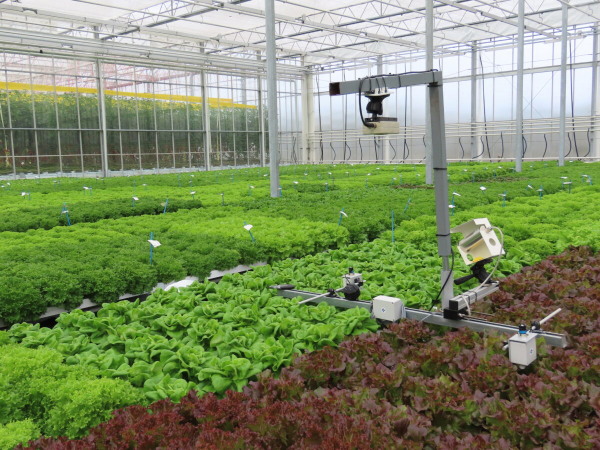Last year, a tomato trial at a BASF Vegetable Seeds facility in the Netherlands showed that the Growing by Plant Empowerment (GPE) principles have the potential to increase yields by as much as 25% in the winter period. With the support of the GPE implementation partners, the crop production strategy has now been fine-tuned and the second trial for tomatoes and additional ones for lettuce and cucumbers are already under way.
 © Plant Empowerment
© Plant Empowerment
BASF Vegetable Seeds ambition is to make healthy eating enjoyable by offering vegetable solutions that are in line with consumers’ needs. Collaborative partnerships are an important part of BASF Vegetable Seeds’ strategy, which is why the multidisciplinary GPE approach is such a good fit. The data-driven cultivation method is based on the principles of physics and plant physiology outlined in the book by P.A.M Geelen, J.O. Voogt and P.A.M. van Weel. It revolves around an integrated approach focused on keeping all the plant balances in equilibrium.
“We previously ran a hydroponic lettuce trial at our site in ’s-Gravenzande based on autonomous and data-driven growing. The results were so impressive that we decided to try it for tomatoes too, so in October 2019 we set up a GPE trial on around 500m2 with a broader team,” says Martin Voorberg, R&D Capital Investment Venture Manager and Project Manager at BASF Vegetable Seeds. That team comprised six GPE Implementation Partners: Hoogendoorn Growth Management which supplied the climate computer, Koppert Biological Systems for pollination and pest management, Hortilux for lighting, the LetsGrow.com data platform, Ludvig Svensson for the screening strategy and stone wool specialist Saint-Gobain Cultilene.
Proactive approach to the crop strategy
Data was continuously collected and analysed during the cultivation process to monitor the effect of the greenhouse conditions on crop performance. “We were keen to try working with higher temperatures and other things we wanted to explore was increased light levels and different light regimes. We wanted to develop a proactive rather than reactive approach to the crop strategy. That meant ‘switching off’ our emotions and allowing ourselves to be led by the data, even if it went against our natural growing instincts,” adds Martin. “On our side, the project was managed by a grower with a lot of experience who is also open to innovation and not afraid of stepping out of his comfort zone.”
No holding back
“What was great about the team at BASF was that even though the growing method didn’t feel ‘normal’, they put their trust in the figures and just did it,” says Mark van der Werf, a nutrition and climate consultant working with the GPE-concept. “If you want to get the most out of GPE, you have to do what the data tells you – no holding back. The human aspect is the most instable factor in crop production. GPE makes it all about physics and mathematics; once you know the right formula for your crop, you can run it all year round. The initial results were amazing, with a 20-25% increase in yield in the winter. But then the crop weakened and lost vigour as we headed into spring.”
This decline in plant performance was discussed in one of the regular GPE meetings, and the proximity of the heads of the plants to the lamps was identified as one of the main practical issues.
Lighting solution
GPE Implementation Partner Hortilux rapidly set about finding a solution. A hybrid system of 65% LEDs and 35% HPS has now been installed. “The LED fittings have created a bit more space between the tops of the plants and the ceiling so the light can be distributed more evenly,” explains Hans de Vries, a consultant from Hortilux. The hybrid system generates more light intensity, but with less heat and also without higher energy costs thanks to the energy-saving nature of LEDs. “By reducing the heat, we give the grower more flexibility in the lighting strategy in order to improve plant health and performance,” adds Hans.
New perspective on crop production
Last year, great results have been achieved such as much higher yield. In the second trial season of GPE, BASF Vegetable Seeds is primarily focusing on maximizing the yield of its main tomato variety, Provine. “Everyone is hugely enthusiastic about the potential. It has been a steep learning curve. I myself have 20 years of experience as a grower but GPE has given me a whole new perspective on crop production. The beauty of data-driven growing is that it makes things more predictable and easier to explain. If we can develop a stable, robust and reproducible strategy based on GPE principles, we can recommend it to our customers to help them get the very best out of this variety. And then we can hopefully do the same for our other varieties and crops in the near future too,” states Martin.
On Tuesday October 20th at 11 am Mark van der Werf and Cees Ammerlaan will give a presentation about the this collaboration during GreenTech Live & Online. Sign up via www.greentech.nl
Do you want to read the whole article? Visit: https://www.plantempowerment.com/userstory/plant-empowerment-at-basf-vegetable-seeds/

